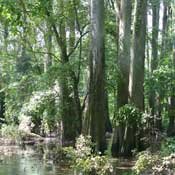A former Mississippi Forestry Commission employee from Franklin County says he can account for the surge in revenue from Section 16 timber sales reported by the Mississippi Secretary of State's office. "They pushed for me and every other county forester to raze just about everything the counties have to offer, which would leave us high and dry on timber production in 11 years," said former Franklin County forester Steve Oglesby, who said he left the agency after he refused to help the state "cash in" much of Franklin County's timber production.
"They told us we would go from a 60-year rotation to a 35-year rotation," said Oglesby. "I prepared a plan, worked almost a year on those plans, and when I turned my plan in, I was sent back with the order to clear-cut practically everything within the next 10-year time period."
Oglesby, who says he was fired for insubordination for not signing off on a 10-year clear-cutting plan, said the Forestry Commission is violating the fundamental rules of forestry management: "If you got 10,000 acres, and you're on a 30-year rotation, you can only cut a third in a ten-year time period. I had 2,200 acres. I was ordered to clear-cut about 3,000 more acres. That put me way over 5,000 acres. But the problem is my county only has 7,600 total forest acres."
The former forester has paperwork from his superiors demanding he increase the clear-cutting by an extra 3,000 acres, and called the demands "reckless."
"If they follow through with this, there has to be a shortfall in the 11th year. I could do it on a sustainable level on a 35-year basis, but a two-thirds reduction isn't the way to go about it. These are school-trust lands, and you have a fiduciary responsibility to keep it running on a sustainable basis. It's so unethical and irresponsible that it ought to be illegal."
Randy Chapin, district forester in Brookhaven, who heads the state's southwest district, confirmed that the commission has reduced the 60-year rotation to a 35-year rotation, but would not comment further on Oglesby, beyond pointing out that the 25-year employee had "been terminated from the commission."
Oglesby said Secretary of State Delbert Hosemann and the state forester Charley Morgan has set a goal of $60 per acre per year of return, and complained that the two signed a memorandum of understanding that amounts to an order to "rape and pillage, and then get out."
"Delbert can do this and make it look good for a few short years, and move on to his next political agenda, and the crap don't hit the fan until 11 years later, after it's someone else's problem," Oglesby said.
Hosemann's office did not return calls. He said in a July press statement, however, that 16th Section land revenues had "skyrocketed 42 percent and put $22.8 million additional dollars into the hands of our school children."
"These numbers show our new system of posting the leases on the Secretary of State's website, arming our School Boards with current financial information, and personally reviewing each lease that comes through our office works and has substantially increased the rate of return on our 16th Section lands," Hosemann stated.
In 12 months ending June 30, 2007, the total amount of funds generated from 16th Section lands, which includes timber and oil and gas leases, was $54,292,624. In 12 months ending June 30, 2008, the revenue increased to $77,109,142, a total gain of $22,816,518. Timber sales, excluding 15 percent timber escrow, in FY 2007 amounted to $9,144,849.81. In FY 2008, revenue from timber sales rose to $10,325,165.21, an increase of nearly $1.2 million, or 13 percent.
The plan that Oglesby says he refused to sign off on contained an order to cut, burn and douse portions of the razed land with an herbicide, possibly in preparation for the construction of tree farms. It is a plan with a strong resemblance to the Forestry Commission's plans for 16th Section land at the end of Westbrook Road, in north Jackson, which is also slated for logging this year.
Jackson resident Jack Westbrook spoke out against the Jackson Public Schools board's recent move to hire a logger to clear-cut a portion of lowland swampland containing pristine cypress trees and old growth timber averaging more than a century in age.
JPS board members said they were following the Forestry Commission's orders in attempting to hire a logger, while Carter Mascagni, a Hinds County service forester with the Mississippi Forestry Commission, said the commission has the right goal.
"Our whole agenda is that we're supposed to be maximizing revenue for school boards," Mascagni said. "Section 16 lands were developed to maximize revenue for the school board, so that's our duty."
Biologists with the Mississippi Museum of Natural Science claim the habitat is unique to Mississippi, containing a cypress swamp, a sandbar, and a viable river bottom habitat as well as hardwood forests and pine prairieseveral micro-environments within a half-mile stretch of territory bordering the Pearl River.
The commission plans to turn a section of the area into a tree farm, despite frequent flooding. Westbrook said Oglesby's assessment seems in line with the commission's new scrutiny of section 16 land, even land with low-cost return: "I don't know if this is Hosemann or somebody working in his office calling the shots, but it seems the secretary of state's office told the Forestry Commission to get every dime they have to squeeze out of every acre."



Comments
Use the comment form below to begin a discussion about this content.